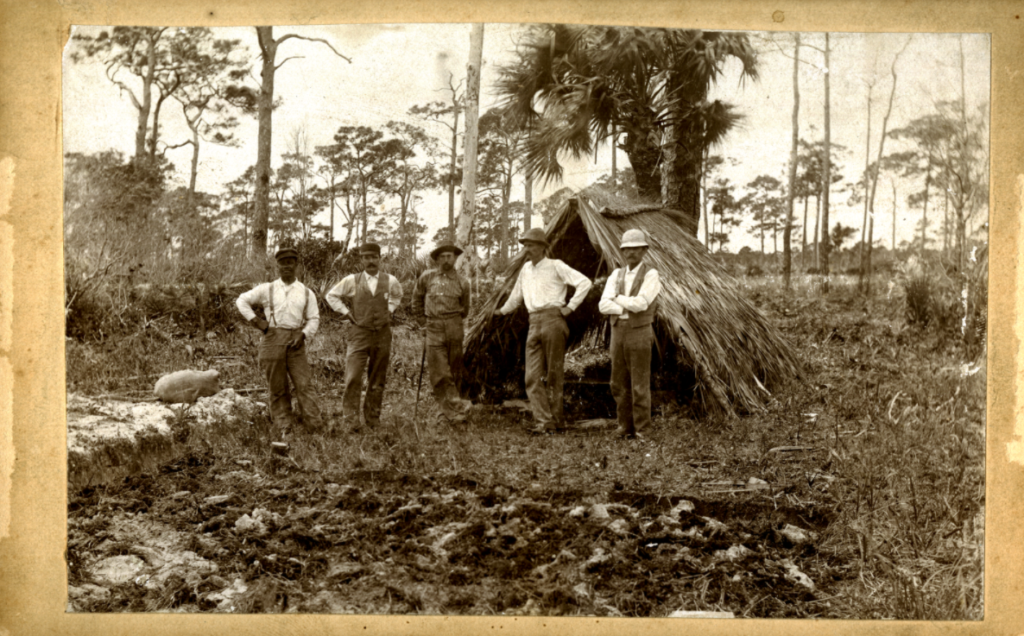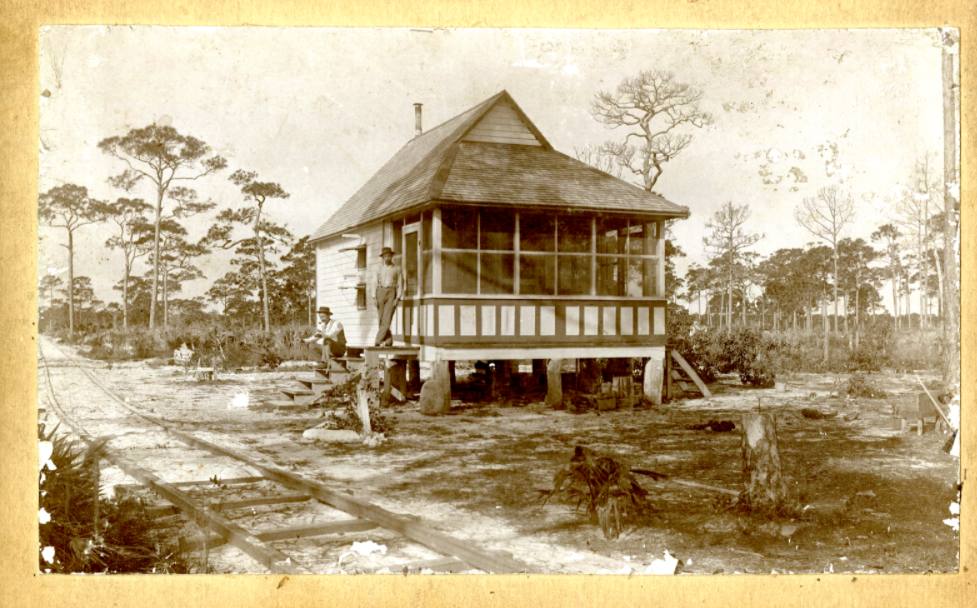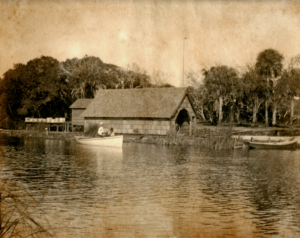My last blog (click here) chronicled the newly discovered photographs of the Lofthus wreck and how Thomas Moore Rickards removed and transported much of the wood from the shipwreck. But who was the photographer of the revealing photographs?
John Henry Moore was born in 1860 in Macoupin County, Illinois, near Springfield. What brought him to Florida in the late 1800s is probably what brought many settlers – a sense of adventure and the possibility of earning decent money by selling pineapples in the summer and tomatoes in the winter in northern markets.
When I found the photographs in the Broward County Library with the mention of Rickards, I made an assumption that Moore’s homestead must have been in the Boca Raton area. What specifically brought him to Boca Raton is unknown. I found a reference to him in the Spanish River Papers, a newsletter of the Boca Raton Historical Society; it mentioned Mr. Moore was raising two acres of pineapples. A map reproduced in the newsletter had a plot of land marked as “Rickards, Lewis & Moore.”
I went to the Palm Beach County Courthouse to find the exact plot of land that Mr. Moore owned. According to the county land records, in 1899 Mr. Moore purchased a lot in Rickard’s subdivision that went from what is today NE 5th Avenue to the Intracoastal Waterway that totaled 13 acres, He paid 200 dollars, equivalent to $6,000 in 2021 dollars.
Boca Raton as a settlement was on the latter end of the pioneer area. Henry Flagler’s Model Land Company owned much of the land in the Boca Raton area, granted from the state of Florida for the building of the Florida East Coast (FEC) railway. Thousands of acres were ready for settlement along the railroad and coastal canal, which came to be known as the Intracoastal Waterway.
To help get the land in the hands of farmers, Flagler’s Model Land Company executive James E. Ingraham hired Thomas Moore Rickards, a surveyor and civil engineer who had much Florida experience, having arrived in the 1870s. Rickards surveyed the land and divided it into farming plots of various acreages, and planted a large orange grove for the FEC. Rickards also helped promote the fledging community of Yamato, an experimental colony of Japanese farmers north of the Boca Raton settlement.
Boca Raton’s main crop area in the pioneer era was pineapples. The sugar sand soil along the coastal ridge wouldn’t support much more than citrus and pineapples. African American settlers grew pineapples in the Pearl settlement near today’s Glades Road; other pineapple farmers were to the south between the FEC railroad tracks and the Intracoastal Waterway.

John Henry Moore stands next to Thomas M. Rickards, who is on the right end with pith helmet. The other men are unidentified.
As pioneers settled their land, they typically built a temporary house of materials from the Florida landscape – a pine frame covered with palmetto fronds. Moore was no different. He is seen standing in the photograph, fourth from the left, with Rickards on the end with pith helmet. Notice the sandy soil and a burlap bag nearby, which may have held sweet potatoes for planting. The tall slash pines had a ground cover of brush and saw palmetto, which had to be grubbed out to plant pineapples or other crops. Saw palmetto are anchored to the ground with tough thick roots that break tools and backs, resisting removal.
In a later photograph, Moore sits on the steps of his home, a typical wood frame house of the day. Nearby we see some wire fencing, and a fish trap sits propped up against the house foundation. The east end of Moore’s land fronted the Intracoastal Waterway, so a fish trap was handy. The other man is unidentified, but could be Moore’s brother. The unusual square openings on the side of the house are worth noting. It looks like there was a mechanism so that the small shutter could be closed from inside the house.

John Henry Moore’s house in Boca Raton. He is sitting on the steps with pipe with scrub jays in hand. A wooden tramway may be where today’s NE 5th avenue runs in Boca Raton.
A few of the photos feature Moore feeding birds from his hand. They are most certainly scrub jays, which inhabit the Florida scrub and are easily tamed. These birds have lost much of their habitat in South Florida, and are now a vulnerable species, limited to large state parks and preserves.
Moore also photographed the lovely view across the waterway to Rickard’s home Poc la Mar. The photographic collection is missing two photos from the original donation, one being Rickard’s home. There is a good look at Rickard’s boathouse, and what appear to be beehive boxes.
It is doubtful that Moore was successful with his pineapple plantation. Although initial crops were profitable, farmers realized that pineapple growing was hard work. A combination of factors doomed the golden dream of pineapples – high freight prices from the Florida East Coast railroad, combined with plant disease and drought cut into profits. Once the railroad went through to Key West in 1912, cheap Cuban pineapples flooded the market. Pineapple growers were finished. After a 1903 hurricane ruined his groves, Rickards bailed out of Boca Raton and moved to North Carolina. Moore sold his land in 1915 to George J. Cranston for $400. Maybe he thought he got a good price – he doubled his money, but it took 16 years.
I began my search to see exactly where Moore’s land was, and what was there today. Using Rickard’s subdivision plat map and a modern section township range map, I pinpointed the spot. To my surprise and joy, it wasn’t all paved over with houses or condos. Much of Mr. Moore’s land is the south end of Lake Wyman Park along NE 5th avenue in Boca Raton. This roadway appears on Rickard’s map as a trail, and could be the wooden rail tramway seen in the photograph of Moore’s house. The southern half of his land had a canal dug as part of the Golden Harbour subdivision platted in the early 1960s.

Thomas Moore Rickard’s Map of Boca Raton, 1900. Moore’s lot was A-5, which stretched to the coast line canal.
I went to Lake Wyman Park on a Sunday morning to imagine what it must have been like – towering Dade County pines still exist on the property, the slow-growing pine that produces wood harder than maple. Some of these trees may even have existed when Moore was there. People passed me in the park, walking their dogs or conversing. I felt as if I had a secret that no one knew as I walked there expecting to see Moore at any moment.
A conservative estimate of what those 13 acres would be worth today is 15 to 20 million dollars. Mr. Moore didn’t find the gold that was there – the gold wasn’t in pineapples, it was in the land. But his lifespan would have never seen that fortune. He left Florida for good; I found him on the 1920 census living in Missouri, running a grocery store with his brother. By 1930, he was in Oregon living near family. He passed away in 1937.
That the photos exist at all is due to the care of Moore’s great niece Cecilie Wilton. In 1988 she wrote to the Broward County Library, wanting to donate the photographs – “I just couldn’t make myself destroy them…” she wrote in a letter accompanying the photographs.
Little did Cecilie Wilton know that the photographs would be rediscovered 33 years later and piece together the story of the Lofthus shipwreck and of a Boca Raton pioneer who had been long forgotten. Her act of kindness gave the opportunity to find these treasures more than a century later, and allow their stories to be told.
Special Thanks to:
Rochelle T. Pienn, Curator, Bienes Museum of the Modern Book, Broward County Library
Alexis Montero, Digital Initiatives Librarian, Broward County Library
Julian McNeill, Broward County Library
Susan Gillis, Curator, Boca Raton Historical Society
Janet Naughton, Librarian, Palm Beach State College
John Henry Moore photographs are courtesy of the Broward County Library






